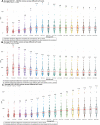Impact of virtual monoenergetic levels on coronary plaque volume components using photon-counting computed tomography
- PMID: 37488295
- PMCID: PMC10667372
- DOI: 10.1007/s00330-023-09876-7
Impact of virtual monoenergetic levels on coronary plaque volume components using photon-counting computed tomography
Abstract
Objectives: Virtual monoenergetic images (VMIs) from photon-counting CT (PCCT) may change quantitative coronary plaque volumes. We aimed to assess how plaque component volumes change with respect to VMIs.
Methods: Coronary CT angiography (CTA) images were acquired using a dual-source PCCT and VMIs were reconstructed between 40 and 180 keV in 10-keV increments. Polychromatic images at 120 kVp (T3D) were used as reference. Quantitative plaque analysis was performed on T3D images and segmentation masks were copied to VMI reconstructions. Calcified plaque (CP; > 350 Hounsfield units, HU), non-calcified plaque (NCP; 30 to 350 HU), and low-attenuation NCP (LAP; - 100 to 30 HU) volumes were calculated using fixed thresholds.
Results: We analyzed 51 plaques from 51 patients (67% male, mean age 65 ± 12 years). Average attenuation and contrast-to-noise ratio (CNR) decreased significantly with increasing keV levels, with similar values observed between T3D and 70 keV images (299 ± 209 vs. 303 ± 225 HU, p = 0.15 for mean HU; 15.5 ± 3.7 vs. 15.8 ± 3.5, p = 0.32 for CNR). Mean NCP volume was comparable between T3D and 100-180-keV reconstructions. There was a monotonic decrease in mean CP volume, with a significant difference between all VMIs and T3D (p < 0.05). LAP volume increased with increasing keV levels and all VMIs showed a significant difference compared to T3D, except for 50 keV (28.0 ± 30.8 mm3 and 28.6 ± 30.1 mm3, respectively, p = 0.63).
Conclusions: Estimated coronary plaque volumes significantly differ between VMIs. Normalization protocols are needed to have comparable results between future studies, especially for LAP volume which is currently defined using a fixed HU threshold.
Clinical relevance statement: Different virtual monoenergetic images from photon-counting CT alter attenuation values and therefore corresponding plaque component volumes. New clinical standards and protocols are required to determine the optimal thresholds to derive plaque volumes from photon-counting CT.
Key points: • Utilizing different VMI energy levels from photon-counting CT for the analysis of coronary artery plaques leads to substantial changes in attenuation values and corresponding plaque component volumes. • Low-energy images (40-70 keV) improved contrast-to-noise ratio, however also increased image noise. • Normalization protocols are needed to have comparable results between future studies, especially for low-attenuation plaque volume which is currently defined using a fixed HU threshold.
Keywords: Atherosclerosis; CT angiography; Coronary arteriosclerosis; Reproducibility of results.
© 2023. The Author(s).
Conflict of interest statement
The authors of this manuscript declare relationships with the following companies:
Michelle C Williams has given talks for Canon Medical Systems and Siemens Healthineers.
Damini Dey has received software royalties from Cedars Sinai Medical Center.
Florian Schwarz and University Hospital Augsburg have received speaker honoraria from Siemens Healthineers.
Figures




Similar articles
-
Technical principles, benefits, challenges, and applications of photon counting computed tomography in coronary imaging: a narrative review.Cardiovasc Diagn Ther. 2024 Aug 31;14(4):698-724. doi: 10.21037/cdt-24-52. Epub 2024 Jul 31. Cardiovasc Diagn Ther. 2024. PMID: 39263472 Free PMC article. Review.
-
High-Pitch Multienergy Coronary CT Angiography in Dual-Source Photon-Counting Detector CT Scanner at Low Iodinated Contrast Dose.Invest Radiol. 2023 Sep 1;58(9):681-690. doi: 10.1097/RLI.0000000000000961. Invest Radiol. 2023. PMID: 36822655 Free PMC article.
-
Carotid artery assessment in dual-source photon-counting CT: impact of low-energy virtual monoenergetic imaging on image quality, vascular contrast and diagnostic assessability.Radiol Med. 2024 Nov;129(11):1633-1643. doi: 10.1007/s11547-024-01889-6. Epub 2024 Sep 17. Radiol Med. 2024. PMID: 39287697 Free PMC article.
-
Effect of Reconstruction Kernel and Virtual Monoenergetic Imaging on Segmentation-Based Measurement of Coronary Plaque Volume With Photon-Counting CT.Invest Radiol. 2025 Sep 1;60(9):602-608. doi: 10.1097/RLI.0000000000001167. Invest Radiol. 2025. PMID: 40009728
-
Multienergy cardiovascular CT imaging: current state and future.Br J Radiol. 2025 Mar 1;98(1167):321-329. doi: 10.1093/bjr/tqae246. Br J Radiol. 2025. PMID: 39656967 Free PMC article. Review.
Cited by
-
Reduction of radiation exposure and preserved image quality using photon-counting detector cardiac computed tomography without electrocardiographic gating in children with congenital heart disease.Eur Radiol. 2025 Jul 3. doi: 10.1007/s00330-025-11719-6. Online ahead of print. Eur Radiol. 2025. PMID: 40608094
-
Spectral Photon-Counting Computed Tomography: Technical Principles and Applications in the Assessment of Cardiovascular Diseases.J Clin Med. 2024 Apr 18;13(8):2359. doi: 10.3390/jcm13082359. J Clin Med. 2024. PMID: 38673632 Free PMC article. Review.
-
Coronary atherosclerotic plaque characterization with silicon-based photon-counting computed tomography (CT): A simulation-based feasibility study.Med Phys. 2024 Dec;51(12):8725-8741. doi: 10.1002/mp.17422. Epub 2024 Sep 25. Med Phys. 2024. PMID: 39321385
-
Editorial: Photon counting CT technology in cardiovascular imaging.Front Cardiovasc Med. 2025 Jun 27;12:1641175. doi: 10.3389/fcvm.2025.1641175. eCollection 2025. Front Cardiovasc Med. 2025. PMID: 40656771 Free PMC article. No abstract available.
-
Technical principles, benefits, challenges, and applications of photon counting computed tomography in coronary imaging: a narrative review.Cardiovasc Diagn Ther. 2024 Aug 31;14(4):698-724. doi: 10.21037/cdt-24-52. Epub 2024 Jul 31. Cardiovasc Diagn Ther. 2024. PMID: 39263472 Free PMC article. Review.
References
-
- Williams MC, Kwiecinski J, Doris M, et al. Low-Attenuation Noncalcified Plaque on Coronary Computed Tomography Angiography Predicts Myocardial Infarction: Results From the Multicenter SCOT-HEART Trial (Scottish Computed Tomography of the HEART) Circulation. 2020;141:1452–1462. doi: 10.1161/CIRCULATIONAHA.119.044720. - DOI - PMC - PubMed
MeSH terms
Grants and funding
LinkOut - more resources
Full Text Sources
Research Materials
Miscellaneous

